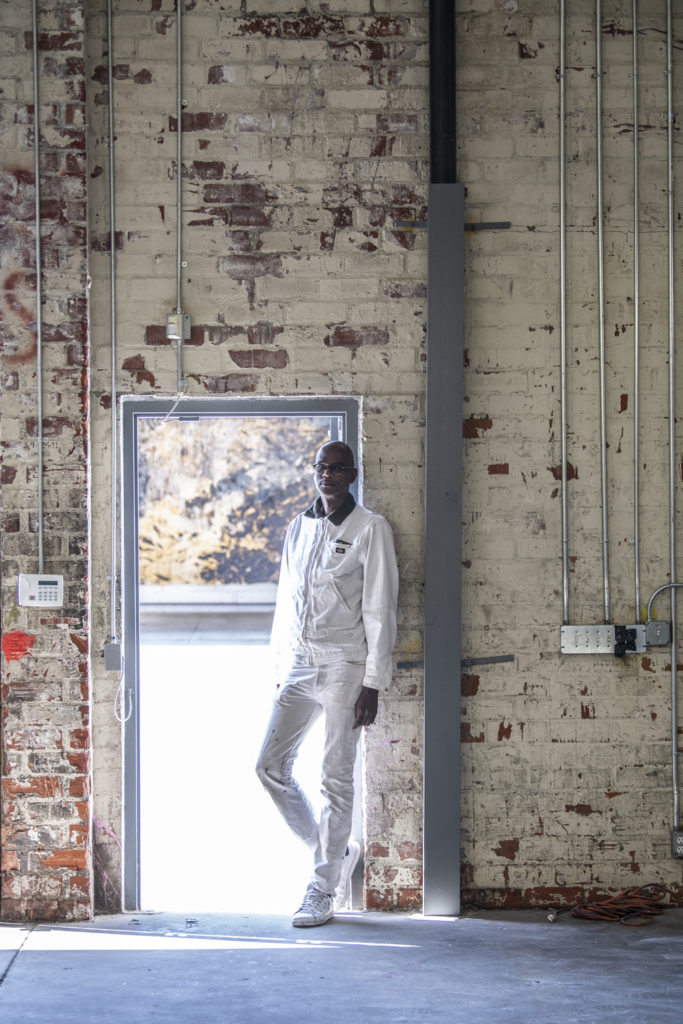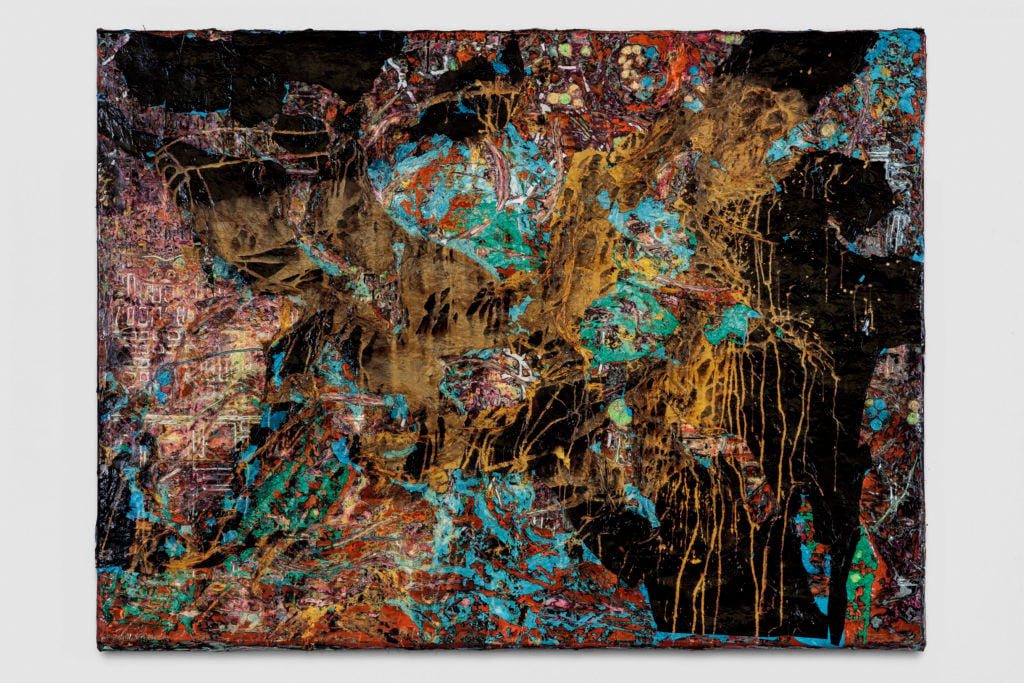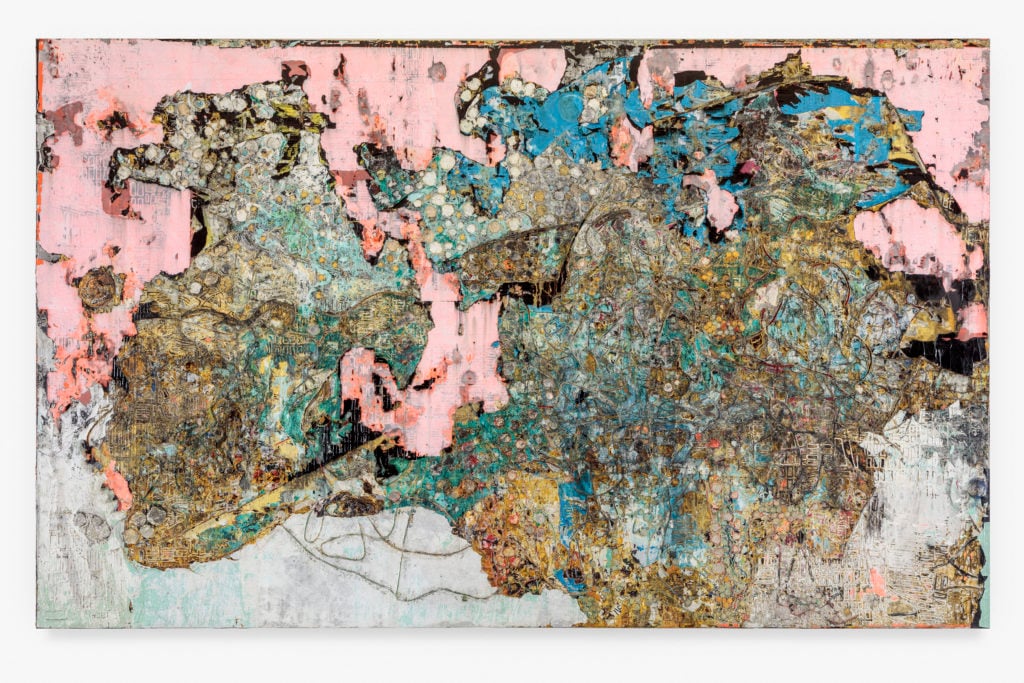On View
Mark Bradford’s Brooding New Show Looks at the Most Urgent Environmental and Political Catastrophes of Our Time
The exhibition is the artist's attempt at contemporary myth-making.

The exhibition is the artist's attempt at contemporary myth-making.

Naomi Rea

Mark Bradford’s first London show with Hauser & Wirth offers a stark, post-apocalyptic vision of the future.
The exhibition, titled “Cerberus,” is named after the mythical three-headed dog that guards the gates of Hades. In the show, monumental works depict an abstract landscape on which legends and actual historical events, such as the 1965 Watts Rebellion in Los Angeles, play out. In total, the works address the widespread dangers of polarized thinking and our neglect of the environmental future.
Bradford’s messy works juggle interconnected issues of class, gender, race, and sexuality, and offer a glimpse into a future in which the eviscerated human race becomes a tangle of peachy intestines.
“For me, the environmental crisis is something that obviously we know has been long-brewing, so at this point it is just looking at it in a holistic way, and saying ‘this is part of our conversation,’ and kind of allowing that to bleed into the work and see what I’m going to do with it, how I feel about it,” Bradford tells artnet News about his latest works.

Mark Bradford, The path to the river belongs to animals (2019). ©Mark Bradford. Courtesy the artist and Hauser & Wirth. Photo by Joshua White.
The environmental paintings—which do not actually involve any paint, but are created through his signature process of layering sodden swathes of pigmented paper—emerged when Bradford was midway through making work for the show.
The exhibition’s enormous titular painting hits on themes that are common in Bradford’s work. Its base layer is a map commissioned by the California governor following the Watts Rebellion in an effort to understand the unrest. Bradford says the map tried to “flatten all that pain into data,” by demarcating so-called “hot spots” of violence, looting, and death. Earlier versions of his works were peppered with these colored spots.
But after a while, Bradford became detached from the trope of the hot spots, and began to pull them off the canvas, realizing that this gave the works an almost botanical look. His urban grid then gave way to an urban jungle, where the forest reclaimed the city. Bradford says the imagery reminded him of the way that, over the course of centuries, trees have crept into the Cambodian temple of Angkor Wat.
The summer of 1965 is also evoked in a video installation, Dancing in the Street (2019), named after a 1964 Motown hit recorded by Martha and the Vandellas. To make the work, Bradford drove around the industrial neighborhood of his Los Angeles studio and projected a video recording of the group performing the song onto the urban landscape.
At the press preview for exhibition, he explained that a myth was built around the song after its release, when some people considered it a call to action. “My mom swears that it was,” Bradford said. “Others say it was just a fun Motown song.”

Mark Bradford, Gatekeeper (2019). © Mark Bradford, courtesy of the artist and Hauser & Wirth. Photo by Joshua White.
“For me, I’m in a space where I can kind of grapple with these large political ideas, and I knew that it wasn’t going to be possible for me to deal with [them] through figuration,” Bradford says. Myths offer a way of prying open polarized conversations.
“It is a way of unearthing these things and really having those uncomfortable conversations to really get to a certain kind of social, fundamental truth about certain things.”
Although the works are dark and brooding, Bradford argues that they are not meant to be despairing, and that a note of hope runs throughout.
“There always has to be hope,” he says. “There always has to be faith. The Civil Rights movement could not have moved forward from slavery to 2019 without hope… So no matter whether the work is bright or dark or turbulent, there is always, fundamentally, a hope, and a faith.”
See a short “making of” film about the exhibition below: